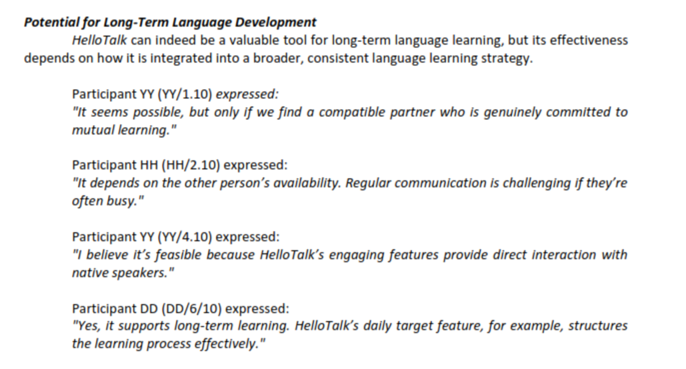Tech-Driven Lifelong Learning: Enhancing Oral Communication Through HelloTalk’s Interactive Features
DOI:
https://doi.org/10.30736/ej.v12i01.1225Keywords:
oral communication, life-long learning, Hello TalkAbstract
Mastering English communication skills is essential in today's globalized world, yet Indonesian students often struggle due to limited authentic practice and reliance on traditional, less interactive methods. This study investigates the use of HelloTalk, a mobile-assisted language learning (MALL) application, to address these challenges by enhancing oral communication skills among English Education students. Specifically, it examines how HelloTalk bridges the gap in real-world language practice while identifying its limitations and proposing solutions. A qualitative case study was conducted, involving semi-structured interviews with six third-semester students taking a Professional Listening and Speaking course at a private university in Surabaya. The results indicate that HelloTalk effectively improves speaking fluency, vocabulary retention, and cross-cultural communication through direct interaction with native speakers. However, key challenges emerged, including difficulties in finding compatible language partners, the lack of message-editing features leading to communication errors, and the app’s high storage consumption. To mitigate these issues, the study proposes a blended learning approach that combines HelloTalk’s interactive strengths with structured classroom instruction, such as targeted grammar exercises and vocabulary drills to create a more balanced and effective learning experience. This integration ensures students benefit from both authentic practice and systematic skill development. The findings highlight the need for technical improvements to HelloTalk and underscore the importance of combining digital tools with traditional pedagogy.
Downloads
References
Arifin, M. N., Heriyanto, E., Kurniadi, D., & Arvianti, I. (2024). Analyzing grammar errors among Hellotalk users and proposing effective correction strategies. 5(1), 26–37.
Aliyeva, K. (2025). Major Characteristics of Language Learning Techniques. Global Spectrum of Research and Humanities, 2(3), 25-34. https://doi.org/10.69760/gsrh.0203025003
Burns, A. (2019). Concepts for Teaching Speaking in the English Language Classroom 1. 12(1), 1–11.
Chung, S. J., & Choi, L. J. (2023). The Use of Mobile Instant Messaging in English Language Teaching: The Case of South Korea. Education Sciences, 13(2). https://doi.org/10.3390/educsci13020110
Dekeyser, R. M. (2013). Age Effects in Second Language Learning : Stepping Stones Toward Better Understanding. March, 52–67. https://doi.org/10.1111/j.1467-9922.2012.00737.x
Febriani, S. C., Widayanti, R., Saputra, H. Y., Safutri, J. T., Bedra, K. G. (2023). Hello Talk: An Alternative Media For Improving Writing Skills For Higher Education. Ta’lim al-‘Arabiyyah: Jurnal Pendidikan Bahasa Arab & Kebahasaaraban, 7(1), 1-13. .
Jalil, H. A. (2023). HOW DO WE LEARN THROUGH TEACHING AND INTERACTION WITH OTHERS IN VIRTUAL LEARNING ? HOW DO WE LEARN THROUGH TEACHING AND INTERACTION WITH OTHERS IN VIRTUAL LEARNING ? Habibah Ab Jalil. May 2011.
Kadwa, M. S., & Alshenqeeti, H. (2020). International Journal of Linguistics, Literature and Translation (IJLLT) The Impact of Students’ Proficiency in English on Science Courses in a Foundation Year Program. International Journal of Linguistics, Literature and Translation (IJLLT), 3(11), 55–67. https://doi.org/10.32996/ijllt
Locke, E. A., & Latham, G. P. (2002). Building a Practically Useful Theory of Goal Setting and Task Motivation: A 35Year Odyssey. September. https://doi.org/10.1037/0003-066X.57.9.705
Miranda, J. A., & Wahyudin, A. Y. (2023). PRE- SERVICE TEACHERS ’ STRATEGIES IN IMPROVING STUDENTS ’ SPEAKING SKILLS. 4(1), 40–47.
Orcid, S. M., Szeged, S., Orcid, L. K., & Szeged, S. (2020). CONSTRUCTIVIST THEORY AS A FOUNDATION FOR THE UTILIZATION OF DIGITAL TECHNOLOGY IN. October, 90–109. 10.17718/tojde.803364
Psenicka, C., & Kos, A. (2012). The Determinants of Effective Presentations : A Factor Analytic Investigation. 29(3), 2012.
Risten, R., Sinaga, F., & Oktaviani, L. (2020). THE IMPLEMENTATION OF FUN FISHING TO TEACH SPEAKING. 1(1), 1–6. 10.33365/jeltl.v1i1.245
Siregar, W. R., Ismahani, S., Islam, U., Sumatera, N., & Medan, U. (2024). The Implementation of HelloTalk Application in Vocabulary Teach- ing for Senior High School. 18(April) 10.15294/lc.v18i2.50282.
Soni, S., & Tofler, A. (2012). Lifelong learning - Education and Training the Illiterates of the 21st Century will not be those who canno. Learning and Teaching Methodology, May, 6–10.
Studies, L., & Kumar, T. (2021). JOURNAL OF LANGUAGE AND LINGUISTIC STUDIES The impact of written visual materials in the development of speaking skills in English language among secondary level students. 17(2), 1086–1095. https://doi.org/10.52462/jlls.76
Wanlu, L. (2021). The Application of Input and Output Theory to Primary English Teaching. 543(Icssed), 34–40. 10.2991/assehr.k.210407.008
Yaghoubi, M., & Farrokh, P. (2022). Investigating Iranian English Learners ’ Private Speech Across Proficiency Levels and Gender Based on Vygotsky ’ s Sociocultural Theory. Journal of Psycholinguistic Study, 51(2), 273–292. https://doi.org/10.1007/s10936-022-09838-y
Yarahmadi, M., & Behbahani, H. K. (2025). The effect of interventionist dynamic assessment on Iranian EFL learners ’ vocabulary learning and retention : a sociocultural inquiry. Language Testing in Asia. https://doi.org/10.1186/s40468-024-00337-6
Yeh, H. C., Chang, W. Y., Chen, H. Y., & Heng, L. (2023). Effects of podcast-making on college students ’ English speaking skills in higher education speaking skills in higher education. Educational Technology Study and Development, 69(5), 2845–2867. https://doi.org/10.1007/s11423-021-10026-3

Downloads
Published
How to Cite
Issue
Section
License
Copyright (c) 2025 Nungki Nurbani, Armelia Nungki Nurbani

This work is licensed under a Creative Commons Attribution 4.0 International License.








